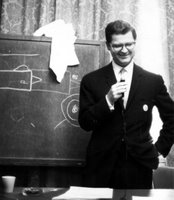It took nearly fifty years, but at last I have the answer to a niggling question that has been stuck in the back of my mind since grade school. The question arose when I acquired the Ballantine paperback editions of the Edgar Rice Burroughs novels about Mars—or “Barsoom,” as Burroughs rendered it. The cover art was by Bob Abbett, whose work was generally evocative of the adventures contained in the books' pages. One cover, however, was just plain wrong. And it was wrong in a way that made no sense at all. I could not figure out how Abbett had messed up so significantly, and that puzzle stayed with me—unresolved until this year.
Abbett established in my mind the figure of John Carter of Mars, the greatest swordsman on two planets. Abbett's painting for the cover of the third Mars book, The Warlord of Mars, is iconic for me, illustrating the stalwart and brooding warrior, sword in hand. The leather strap across Carter's chest is studded with the metal device (similar to the horned chevron of the Cadillac logo) that I took to be the symbol of the Prince of Helium. Abbett's depiction became for me the quintessential John Carter. (Sorry, Taylor Kitsch; you're not quite in that league.)
On the cover of the first Mars book, A Princess of Mars, Carter is plying his sword in defense of the incomparable Dejah Thoris (who apparently trademarked “incomparable” as her personal adjective). On the cover of the second book, The Gods of Mars, there's John Carter floating in space next to a spaceship!
Huh?!
Something is terribly, terribly wrong. Burroughs had no spaceships in his Barsoom books. John Carter made the transition between Earth and Mars via a strange kind of teleportation, which Burroughs did not deign to explain. No spaceships. But Abbett painted a very recognizable rocketship, fins and all, for Mars book #2. Where the heck did that come from?
I now know it came from 1918. It came from a simple misreading of Frank Schoonover's cover art for the book's original publication. Abbett mistook Schoonover's Barsoomian flier for a spacecraft. Ballantine's cover artist took too casual a look at his predecessor's illustration.
Actually, I'm not surprised that Abbett wasn't too impressed by the original cover art. It's rather disappointing. Schoonover's art for The Gods of Mars is extremely faithful to an incident bridging the end of Chapter 6 and the beginning of Chapter 7. That's the main point in its favor. John Carter is clinging to the anchor chain of a flying war vessel manned by the First Born of Barsoom, a proud and handsome race of black Martians who fancy themselves the original intelligent life on the planet (with all other races being their debauched and devolved descendants).
I commenced to climb slowly up the anchor chain toward the deck above me.The First Born mistakes Carter for one of Barsoom's therns—despised fair-skinned rivals of the First Born—because Carter is still wearing the blond wig he used in his escape from the clutches of the therns. Schoonover paints a rather chunky looking (and practically middle-aged) Carter clinging to the anchor chain, comical blond wig on his head, and a coal-black antagonist getting the drop on him. Abbett dispensed with the wig, painted instead his more robust version of John Carter, and replaced the flier with a rocket ship in orbit about Mars.
One hand had just reached for the vessel's rail and found it when a fierce black face was thrust over the side and eyes filled with triumphant hate looked into mine.
For an instant the black pirate and I remained motionless, glaring into each other's eyes. Then a grim smile curled the handsome lips above me, as an ebony hand came slowly in sight from above the edge of the deck and the cold, hollow eye of a revolver sought the centre of my forehead.
Simultaneously my free hand shot out for the black throat, just within reach, and the ebony finger tightened on the trigger. The pirate's hissing, “Die, cursed thern,” was half choked in his windpipe by my clutching fingers.
Poor John Carter, of course, must be holding his breath as he floats weightless next to the spaceship, high above Mars and its thin atmosphere. His red kilt seems hardly a proper substitute for a pressure suit. A hatch atop the ship is ajar, but no First Born has yet emerged to shove a gun in Carter's face.
Never mind. Abbett simply made a whopper of a mistake. The cover for The Gods of Mars is the one egregious error in the Ballantine edition of the Mars books. One could even say that Abbett redeemed himself when he rendered the cover of Mars book #7, A Fighting Man of Mars, which shows some properly air-bound flying vessels much more in keeping with Barsoomian fliers. That's more like it!
I can rest easy now, with one less nagging mystery gathering dust in my mental archives.




































